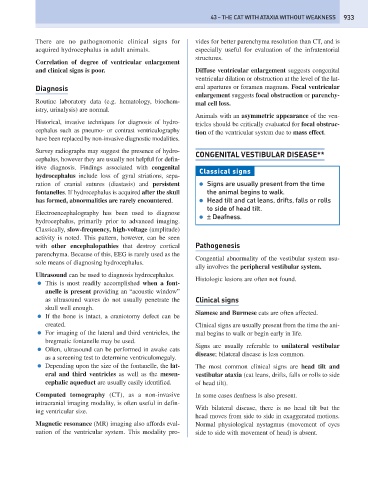Page 941 - Problem-Based Feline Medicine
P. 941
43 – THE CAT WITH ATAXIA WITHOUT WEAKNESS 933
There are no pathognomonic clinical signs for vides for better parenchyma resolution than CT, and is
acquired hydrocephalus in adult animals. especially useful for evaluation of the infratentorial
structures.
Correlation of degree of ventricular enlargement
and clinical signs is poor. Diffuse ventricular enlargement suggests congenital
ventricular dilation or obstruction at the level of the lat-
Diagnosis eral apertures or foramen magnum. Focal ventricular
enlargement suggests focal obstruction or parenchy-
Routine laboratory data (e.g. hematology, biochem- mal cell loss.
istry, urinalysis) are normal.
Animals with an asymmetric appearance of the ven-
Historical, invasive techniques for diagnosis of hydro- tricles should be critically evaluated for focal obstruc-
cephalus such as pneumo- or contrast ventriculography tion of the ventricular system due to mass effect.
have been replaced by non-invasive diagnostic modalities.
Survey radiographs may suggest the presence of hydro-
CONGENITAL VESTIBULAR DISEASE**
cephalus, however they are usually not helpful for defin-
itive diagnosis. Findings associated with congenital
Classical signs
hydrocephalus include loss of gyral striations, sepa-
ration of cranial sutures (diastasis) and persistent ● Signs are usually present from the time
fontanelles. If hydrocephalus is acquired after the skull the animal begins to walk.
has formed, abnormalities are rarely encountered. ● Head tilt and cat leans, drifts, falls or rolls
to side of head tilt.
Electroencephalography has been used to diagnose
● ± Deafness.
hydrocephalus, primarily prior to advanced imaging.
Classically, slow-frequency, high-voltage (amplitude)
activity is noted. This pattern, however, can be seen
with other encephalopathies that destroy cortical Pathogenesis
parenchyma. Because of this, EEG is rarely used as the
Congential abnormality of the vestibular system usu-
sole means of diagnosing hydrocephalus.
ally involves the peripheral vestibular system.
Ultrasound can be used to diagnosis hydrocephalus.
Histologic lesions are often not found.
● This is most readily accomplished when a font-
anelle is present providing an “acoustic window”
as ultrasound waves do not usually penetrate the Clinical signs
skull well enough.
Siamese and Burmese cats are often affected.
● If the bone is intact, a craniotomy defect can be
created. Clinical signs are usually present from the time the ani-
● For imaging of the lateral and third ventricles, the mal begins to walk or begin early in life.
bregmatic fontanelle may be used.
Signs are usually referable to unilateral vestibular
● Often, ultrasound can be performed in awake cats
disease; bilateral disease is less common.
as a screening test to determine ventriculomegaly.
● Depending upon the size of the fontanelle, the lat- The most common clinical signs are head tilt and
eral and third ventricles as well as the mesen- vestibular ataxia (cat leans, drifts, falls or rolls to side
cephalic aqueduct are usually easily identified. of head tilt).
Computed tomography (CT), as a non-invasive In some cases deafness is also present.
intracranial imaging modality, is often useful in defin-
With bilateral disease, there is no head tilt but the
ing ventricular size.
head moves from side to side in exaggerated motions.
Magnetic resonance (MR) imaging also affords eval- Normal physiological nystagmus (movement of eyes
uation of the ventricular system. This modality pro- side to side with movement of head) is absent.

